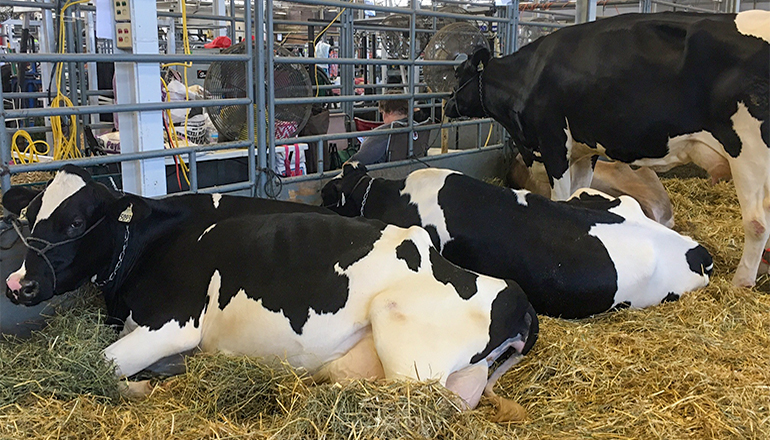Fair season and heat put three key groups at risk of heatstroke: livestock, their owners and spectators.
Timing and flexibility are critical when transporting animals to and from the fair, says Daniel Mallory, University of Missouri livestock field specialist. Take animals to the fair early in the morning when temperatures are cooler so animals remain cool while being transported and unloaded.
Closely confined animals face the most serious risk, so plan to carry fewer animals in more trips, Mallory says. Do not crowd animals in trailers, especially during hot, humid days.
Adjust ventilation and bedding to increase livestock comfort. Use sawdust, shavings, sand or a combination of these to line the floor of trailers. Avoid straw, especially oats straw, in vehicles with solid sides. Use “wet” bedding in “shirt-sleeve” weather.
MU Extension’s “Hot Weather Livestock Stress” guide gives tips on how to use MU’s Livestock Weather Guide to determine relative humidity and stress categories.
When cooling animals, avoid “shock” from cold water. A coarse mist lowers temperatures to a safe level and improves animal comfort. Choose large droplets over a fine mist for best results.
Put hogs on “wet” bedding for best comfort. Hogs and some other animals cannot perspire, so watch them carefully for signs of heat stress. Cattle sweat at only 10% of the human rate, so they, too, should be given special attention.
Stale, stagnant air becomes lethal in a short time. Watch for outwardly physical signs of stress such as panting and lethargy. Stick to regular feeding schedules, but be mindful that animals, like humans, eat less when hot, says Mallory.
Dairy cattle have special nutritional needs. See the “How to Reduce Heat Stress in Dairy Cattle” guide for information on how to protect your dairy cattle.
Use rapid-movement fans in livestock barns. Keep water supplies handy and provide shade at all times.
When attending fairs, be proactive, says MU Extension health and safety specialist Karen Funkenbusch. Heat deaths are 100% preventable with water, rest and shade, she says.
She offers the following tips for fair participants and spectators:
- Take fans, water jugs filled with cool drinking water and moistened wipes to the fair.
- Choose chairs that are comfortable and have good airflow. Dress in light-colored, loose-fitting, comfortable clothing. Bring fresh clothes to change into before showing animals.
- Seek treatment, if needed, for heat rash, excessive sweating, dizziness, loss of consciousness, cramps, nausea, weakness, slurred speech or confusion.
- Drink water often. Do not wait until you are thirsty. Keep a supply of cool drinking water as you travel, on the farm or on the road, in the event of delays or breakdowns.
- Take frequent breaks.
- Check prescriptions for side effects associated with heat.
- Check on others at the fair, including spectators such as grandparents, babies, and workers. Dehydration caused by heat can cause elderly people to fall on unstable show arenas.
Since 1980, heatwaves in Missouri have killed more people than lightning, tornadoes, thunderstorms, and floods combined, says MU Extension climatologist Pat Guinan.
Funkenbusch recommends the U.S. Occupational Safety and Health Administration’s Heat Safety Tool, a smartphone app that lets workers calculate the heat index for their worksite and displays a risk level for outdoor workers. Working in full sunlight increases heat index values by 15 degrees, according to OSHA.







